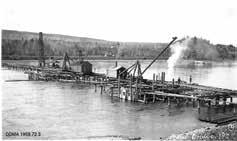
4 minute read
HISTORY OF BC
The Interesting History of the Bridge in Quesnel, BC
Ron Hyde
At the start of the 20th century, a canoe served as a mini-ferry and provided the only way to cross the Fraser River from the town of Westside to the City of Quesnel.
In 1911, the provincial government supplied the financing for a cable or chain ferry to go into service.
Quesnel canoe ferry
Quesnel District Museum & Archives 1989.87.1

Quesnel Cattle Ferry
After extensive lobbying by local businessowners and after the provincial election in 1928, the new Conservative Government lived up to their election promise to see the work started; within 10 days the contractor in charge of building the structure arrived in Quesnel.
On August 20, pile-driving started; concrete was poured for the first pier on October 13. With the mild Winter, the work continued and the last pier was poured in January.

Construction of the bridge started in 1928.
Quesnel District Museum & Archives No. 1958.72.3
Unfortunately one fatality occurred. Stuart Wilson was killed January 23 due to a defective fuse while he was dynamiting large blocks of ice as they neared the bridge.
Fortunately the river froze over January 28; that made the construction of the superstructure much easier. In February, a second accident occurred . . . Joe Rousseau fractured his ribs and an ankle when a timber fell from the top of the bridge.
Unfortunately in those times, safety was not a factor; hard hats and safety harnesses were not even considered.
Although the original plans were for a steel bridge, in 1928 the decision was made to use wood.
The Kersley Farmers Institute petitioned for the bridge timber to be cut locally but it was cut and prepared in Vancouver and shipped by rail to Quesnel. Each piece was cut to size and shape and a numbered plan was created to show where each piece was to be placed; the timbers were all treated with creosote.
A major problem arose when the foreman in charge of the framing was discharged and he took the master numbered plan with him.
Fortunately Bert Alcock, of the Department of Public Works, was able to recreate the master numbered plan from the numbered timbers and the Howe Trusses.
The new bridge opened to the public March 8, 1929; the official opening became part of the annual May Day celebrations. The Fraser
River walking bridge In Quesnel had an 831-foot span and was the longest wooden Howe Truss bridge in the world.
At the time the bridge opened, traffic was limited to pedestrians, horse-drawn vehicles, and the occasional motor vehicle; the 10-ton load limit was quite adequate. A speed sign installed on the bridge is now part of the Quesnel Museum’s collection.

Bridge Speed Sign
Quesnel District Museum & Archives Collection
The bridge stimulated the growth of West Quesnel and greatly aided with the Fall cattle drive when ranchers from the Chilcotin, Nazko, and other ranching areas drove as many as 400 cattle across it for auction in Quesnel. Previously, cattle and the accompanying cowboys swam across the river.

Cattle crossing during the Fall cattle drive to Quesnel for auction.
Quesnel District Museum & Archives 1993.83.25
Quesnel was the northern terminus for the British Columbia Pacific Great Eastern Railway. During World War II, it was an important link in Canada’s war effort.
On the west side of the Fraser River, birch trees were harvested and shipped from Quesnel and used to make plywood for the construction of the Mosquito bomber. As the lumber industry grew, the bridge became inadequate for larger trucks, so stop lights were installed in 1954 to allow only single lane traffic.

The Howe Truss: A Howe truss is a truss bridge consisting of chords, verticals, and diagonals whose vertical members are in tension. The bridge is in Quesnel, the major city between Williams Lake and Prince George. Westside is the neighbourhood across the Fraser River from Quesnel and the bridge connects the two together as they are one city.

The Mosquito Bomber…an airplane bomber that was a major asset for the allies during WWII
The bridge stimulated the growth of West Quesnel and greatly aided with the Fall cattle drive when ranchers …drove as many as 400 cattle across it for auction in Quesnel.
Lobbying for a new bridge was successful after the Cariboo Pulp Mill project was announced; the Moffatt Bridge was completed in 1971.
The wooden bridge, a valued community asset, was maintained for pedestrians and is now the centrepiece of Quesnel s Waterfront Trail system.
In 2010, the bridge was restored with funds from Western Economic Diversification Canada and the City of Quesnel; the maintenance extended its life by many decades. The decking and many trusses were replaced and one of Canada s best examples of outdoor programmable lighting was installed; the new lights use less power that would be used by two hair dryers. s History is Ron Hyde’s passion. Before he retired, he worked for the Liquor Distribution Branch and wrote a Reflections column for their monthly newsletter. A member of the B.C. Historical Federation for 20 years, he has written several articles for their BC History magazine and was their newsletter Editor for 42 issues. SOURCES Special thanks to Elizabeth Hunter and the City of Quesnel Museum and Archives for their great assistance.







